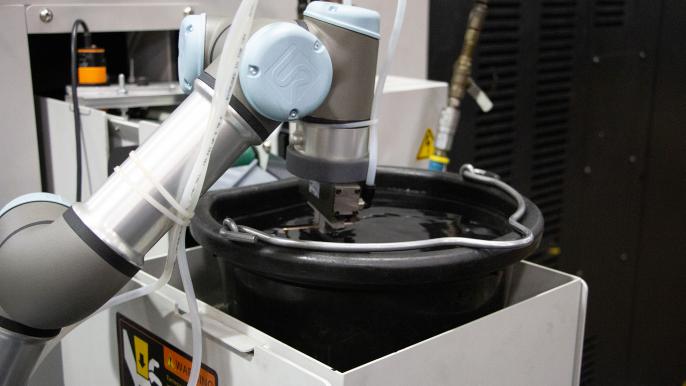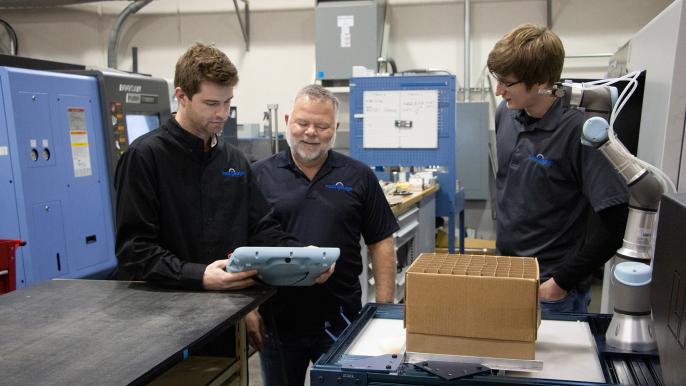
Boeing’s aerospace suppliers in the Pacific Northwest are feeling a three-pronged crunch as the 737 MAX grounding drags on, Boeing considers giving up its Washington state tax break to avoid European tariffs and the area faces a skilled workforce shortage. Tool Gauge, a Tacoma-based aerospace manufacturer, is working to solve these challenges through a symbiotic pairing of workforce initiatives and automation.
The company received a $125,000 Work Start grant from the Washington State Department of Commerce last year to support an estimated 100 new workers to meet ramped up production for the 777X, but despite training and apprenticeship initiatives, hiring was a challenge.
“It became clear to us that the way that we can compete is not by adding more bodies, but by adding more technology, and then adding more value using that technology,” says Jim Lee, general manager, Tool Gauge. One technology the company has implemented to improve productivity is collaborative robots—or “cobots”—from Universal Robots.

Tool Gauge recently added two cobots for tasks that Lee describes as repetitive, “mindless labor”— rinsing, drying and boxing machined metal parts and gluing end caps for plastic panels. According to the company, implementation of the cobots has not only improved work consistency, reduced scrap rates and decreased repetitive motion injuries, but it has also doubled production output and delivered 75% in labor cost savings.
“The reason why we’re so focused on cobots is we have a factory of the future we want to build, and a lot of what we see in the factory of the future is eliminating repetitive motion, nonskilled labor—stuff that people don’t really want to do like move a pallet of parts from one end of the factory to the other or sit at an assembly cell and do very intricate gluing of parts all day long,” says Lee. “We like to use people for their brains and not their backs.”
Lee says using cobots has freed up existing employees to do more “brain-focused work” and mitigated the number of new hires needed for unskilled labor, which is becoming increasingly difficult to find in a competitive environment. According to Lee, Tool Gauge’s employees find the addition of the robots to be a more rewarding scenario, and younger generations find work with the robots to be more appealing as well. The company recently branched out from its youth-focused apprenticeship program and has started bringing younger students in for tours of the facility, many of whom have been “blown away by the cobots” according to Lee.

Looking forward, Tool Gauge plans to implement various types of robots in three phases. In addition to adding more cobots for high-volume jobs such as riveting and assembly, Tool Gauge is working to implement custom Viper robots on some of its machining equipment and planning to add mobile industrial robots (MiR) to eliminate traffic and forklifts on the floor. The MiR bots will enable Tool Gauge to move parts straight off the production line into the warehouse via custom-built carts that are delivered to Boeing. Lee says the robots will reduce direct labor while transporting parts, which will make Tool Gauge more efficient and competitive.
Adding to Tool Gauge’s “factory of the future” is a brand new facility, which began construction in late 2018 and is expected to be complete in May. The more than 80,000 ft.2 facility replaces six legacy buildings from the 1970s and earlier, and incorporates best practices from state-of-the-art Airbus and Boeing factories, including new machining equipment and a vertical paint system.
Lee says that although operations will be “tight” for Tool Gauge this year, he expects 2021 to be “a fantastic growth year.”





